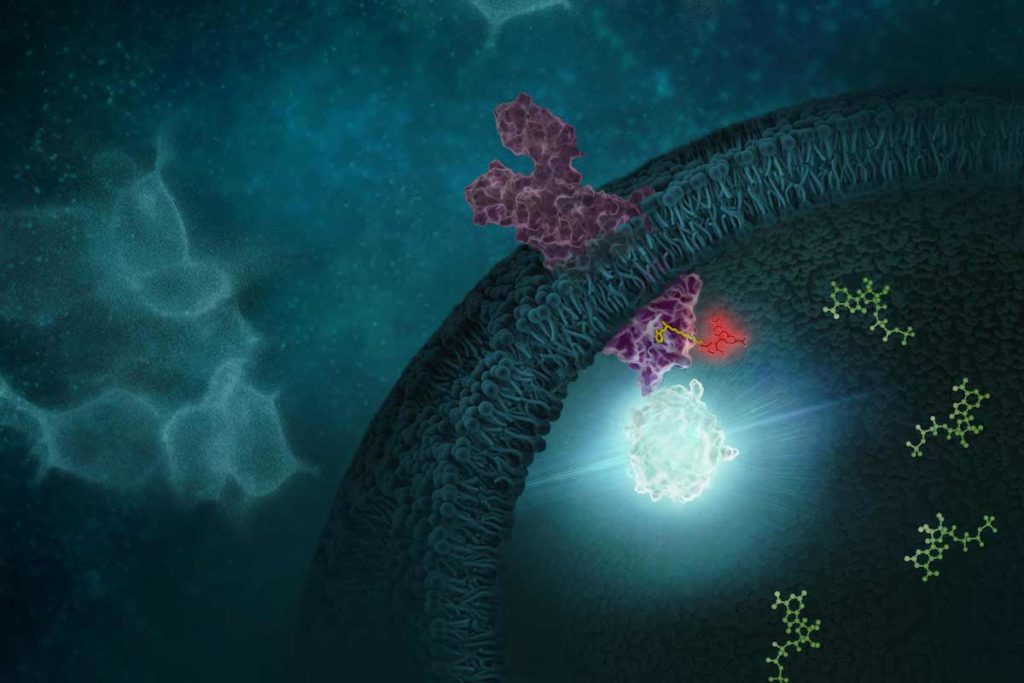
G protein-coupled receptors (GPCRs) comprise a large group of cell surface receptors, characterized by the unique structural property of crossing the cell membrane seven times. They respond to a diverse group of signaling molecules, such as peptides, neurotransmitters, cytokines, hormones and other small molecules (1). Upon activation, GPCRs interact with GTP-binding (G) proteins and arrestins to regulate a wide variety of signaling pathways. This broad range of functions makes GPCRs attractive targets for drug discovery. The importance of GPCR research was highlighted in 2012, with the Nobel Prize in chemistry being awarded to Robert Lefkowitz and Brian Kobilka “for studies of G-protein–coupled receptors”.
Based on structure and function, GPCRs are categorized into six classes, A–F. The class A GPCRs, or rhodopsin-like receptors, have been studied extensively due to their association with many types of diseases (2). Within the class A GPCRs is a group that share a highly conserved structural motif (3) and respond to chemokines—small “chemotactic cytokines” that stimulate cell migration, especially that of white blood cells (4). A subfamily of class A GPCRs respond to chemokines that have two cysteine residues near the N-terminus, known as CC chemokines. GPCRs activated by CC chemokines are called CC chemokine receptors or CCRs, and these interactions have been implicated in both pro- and anti-cancer pathways (5).
GPCRs as Drug Discovery Targets
Most drug discovery efforts targeting GPCRs take advantage of small-molecule compounds (GPCR agonists or antagonists) that have a high affinity for the specific GPCR being targeted. However, that affinity, as demonstrated in vitro or by computational modeling, does not always translate to high efficacy in clinical trials.
As an example, Huber et al. examined a well-characterized small molecule inhibitor of the chemokine receptor CCR9 (6). “CCR9 activation by its endogenous ligand, the chemokine CCL25, plays a key role in leukocyte recruitment,” says Dr. Matthias Schiedel, Chair of Medicinal Chemistry, Friedrich-Alexander-Universität Erlangen-Nürnberg (FAU). Dr. Schiedel is the corresponding author for the publication. He explains that dysregulation of CCR9-mediated signaling has been associated with the pathogenesis of inflammatory diseases, including Crohn’s disease and ulcerative colitis. “Therefore,” he says, “CCR9 has gained attention as a potential drug target for the treatment of inflammatory bowel diseases.” It has also recently been suggested as a potential target for treatment of COVID-19 (7).
The researchers studied the compound vercirnon that had previously demonstrated a high affinity for CCR9 but had proved ineffective in phase 3 clinical trials for treatment of Crohn’s disease (8). Dr. Schiedel cited several potential reasons for this result, including poor solubility of vercirnon (9) and covalent binding of the biaryl ketone pharmacophore to albumin (10). In addition, differences in the patients recruited as compared to phase 2 trials (11) could have affected the results.
Previous studies to measure the engagement of vercirnon with CCR9 used established radioligand binding, cell-free assays (12). “Radioligand binding assays are often based on heterogeneous assay protocols, requiring the removal of the unbound radioligand fraction prior to detection,” says Dr. Dorothée Weikert, who is also a researcher and Chair of Medicinal Chemistry at FAU, and a co-author of the present study (6). “Thus, radioligand binding assays do not allow a continuous readout and cannot be easily downscaled.” In addition, these assays come with all the drawbacks of using radioactive tracers—high infrastructure costs for radiation protection measures and waste disposal.

Degraders, Not Inhibitors
The researchers considered a novel approach to enable better drug discovery options for targeting the intracellular allosteric binding site (IABS) of CCR9. Their team developed a fluorescently labeled analog of vercirnon, after evaluating several compounds in cell-based, kinetic binding assays using NanoBRET™ technology.
“The key advantage of the NanoBRET™ technology is, for sure, the possibility of a low volume design (384-well plates) and a continuous assay readout,” Dr. Weikert says. Thus, the team was able to observe real-time kinetics of the fluorescently labeled vercirnon analogs binding to CCR9 in a straightforward, high-throughput format. They showed that the interaction between CCR9 and the vercirnon scaffold is characterized by a long residence time, which explains the high affinity and outstanding CCR9 selectivity of vercirnon (6). Since NanoBRET™ technology can be used both for cell membrane preparations and intact, live cells, Dr. Weikert says the method “also provided us with direct information on whether a novel compound or fragment is able to cross the cell membrane and reach its intracellular target in intact cells.” Further kinetic measurements using their NanoBRET™ screening platform enabled the researchers to identify novel intracellular CCR9 ligands.
Interestingly, the screening experiments showed that the IABS of CCR9 was able to tolerate heterobifunctional ligands (6). This result opened up an exciting alternative to the traditional drug discovery approach of designing CCR9 inhibitors: using targeted protein degradation with PROTACs to ultimately destroy CCR9.
“In general, PROTACs feature superior in vivo efficacy, compared to standard inhibitors,” Dr. Schiedel says. This efficacy has been attributed to their sustained pharmacological effects, since degradation of the target protein is irreversible. Their catalytic action is a benefit, he adds, because “one equivalent of the PROTAC molecule can induce the degradation of several equivalents of the target protein.” Dr. Weikert also explains that “protein degradation may lead to more consequences for cellular function than just inhibition or allosteric modulation of a receptor’s signaling from the plasma membrane.”
The researchers conducted a proof-of-principle study using a vercirnon-derived PROTAC as a CCR9 degrader. This compound reduced cellular CCR9 levels, assessed by enzyme-linked immunosorbent assay (ELISA), at 1–25nM concentrations. Additionally, the CCR9 degradation effect was reduced by the NEDD8-activating E1 enzyme inhibitor MLN4924 (13), which inhibits the process of ubiquitination and subsequent proteasomal degradation.
Dr. Schiedel concludes that, for CCR9, where occupancy-driven inhibitors of protein function (e.g., vercirnon) have shown limited therapeutic efficacy, “the application of the PROTAC strategy is highly promising to overcome this limitation.”
References
- Glukhova, A. et al. (2018) Rules of engagement: GPCRs and G proteins. ACS Pharmacol. Transl. Sci. 1, 73−83.
- Basith, S. et al. (2018) Exploring G protein-coupled receptors (GPCRs) ligand space via cheminformatics approaches: impact on rational drug design. Front. Pharmacol. 9, 128.
- Arimont, M. et al. (2019) Chemokine receptor crystal structures: what can be learned from them? Mol. Pharmacol. 96, 765–777.
- Hughes, C.E. and Nibbs, R.J.B. (2018) A guide to chemokines and their receptors. FEBS J. 285, 2944–2971.
- Korbecki, J. et al. (2020) CC chemokines in a tumor: a review of pro-cancer and anti-cancer properties of receptors CCR5, CCR6, CCR7, CCR8, CCR9, and CCR10 ligands. Int. J. Mol. Sci. 21, 7619.
- Huber, M.E. et al. (2022) A chemical biology toolbox targeting the intracellular binding site of CCR9: fluorescent ligands, new drug leads and PROTACs. Angew. Chem. Int. Ed. e202116782.
- Schmeidel, B. et al. (2021) COVID-19 genetic risk variants are associated with expression of multiple genes in diverse immune cell types. Nat. Commun. 12,6760.
- Feagan, B.F. et al. (2015) Randomised clinical trial: vercirnon, an oral CCR9 antagonist, vs. placebo as induction therapy in active Crohn’s disease. Aliment. Pharmacol. Ther. 42, 1170–1181.
- Zhang, J. et al. (2015) Biarylsulfonamide CCR9 inhibitors for inflammatory bowel disease. Bioorg. Med. Chem. Lett. 25, 3661–3664.
- Narita, N. et al. (2018) Mechanism for covalent binding of MLN3126, an oral chemokine C-C motif receptor 9 antagonist, to serum albumins. Drug Metab. Dispos. 46, 204–213.
- Wendt, E. and Keshav, S. (2015) CCR9 antagonism: potential in the treatment of inflammatory bowel disease. Clin. Exp. Gastroenterol. 8, 119–130.
- Oswald, C. et al. (2016) Intracellular allosteric antagonism of the CCR9 receptor. Nature 540, 462–465.
- Soucy, T.A. et al. (2009) An inhibitor of NEDD8-activating enzyme as a new approach to treat cancer. 458, 732–736.
Learn more about NanoBRET™ technology for studying drug-target engagement.
Latest posts by Ken Doyle (see all)
- Will Artificial Intelligence (AI) Transform the Future of Life Science Research? - February 1, 2024
- RAF Inhibitors: Quantifying Drug-Target Occupancy at Active RAS-RAF Complexes in Live Cells - September 5, 2023
- Synthetic Biology: Minimal Cell, Maximal Opportunity - July 25, 2023
